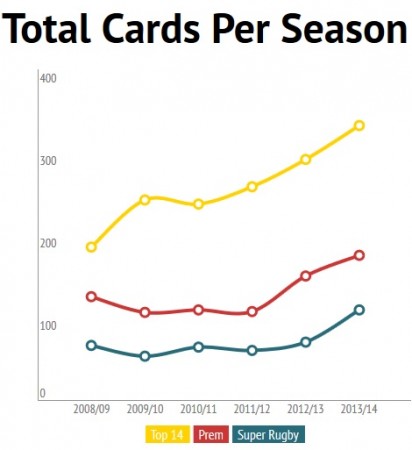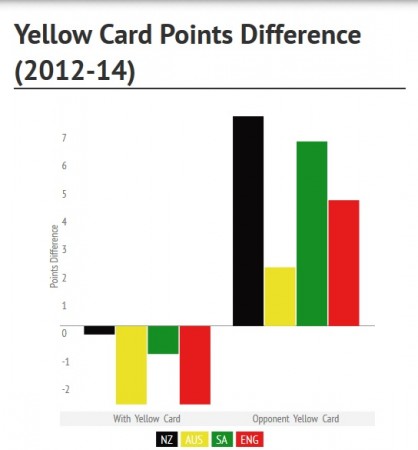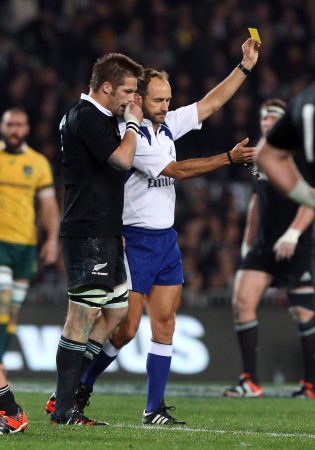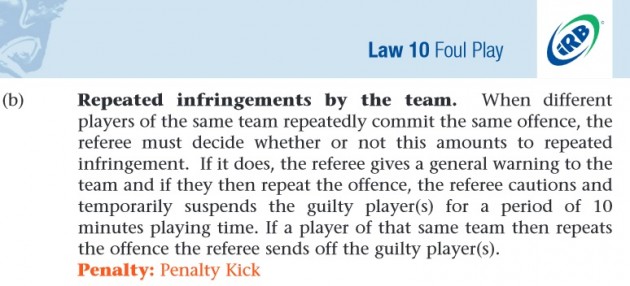In his second outing as Rugby World's stats man-in-chief, Russ Petty, looks at the true impact of yellow cards and whether taking a sin-binning really does resign your side to a certain number of points conceded...
There is a common belief that a team receiving a yellow card will be punished by an average of seven points during the following sin-bin, but is that actually true?
Unsurprisingly, the number of cards shown per average game does vary between competitions. There is scope for different interpretation of the laws depending on the referee and the accepted standard of behaviour does change for each tournament. While a Top 14 contest doesn’t really start until the forwards have exchanged pleasantries in the first brawl, such conduct is much rarer in the ITM Cup.
Allowing for those variations between leagues, it can still be seen below that the number of cards being handed out has increased over the last three seasons. In theory a greater certainty of being ‘punished’ should have seen the number of cards decrease. Greater scrutiny on certain offences (tackled in the air, ‘tip tackles’ etc) may explain the rise. But, perhaps the issue is the severity of the punishment. Rather than acting as a deterrent, in some cases are yellow cards actually incentivising cynical play?
In a recent Rugby Championship game, Australia outscored South Africa by ten points to nil after the visitors had been reduced to fourteen men. The Wallabies were trailing by nine points before Bryan Habana left the field but ended up winning the match by one.
That level of scoring, particularly in a high profile game may reinforce that conventional wisdom of a card being worth at least the equivalent of a converted try. However, the events in Perth were uncommon for both sides. Since 2012, South Africa have averaged just a minus one (-1) point deficit when down a man, while Australia have managed a two point advantage against teams who have a conceded a card.
In both those scenarios it has been more likely for there to be no gain from a sin-bin rather than a seven-point swing.
As might be expected, the strength of the sides involved is a factor in how well the extra man advantage is exploited. As an example, South Africa average just a two point difference against Australia or New Zealand compared to ten points when facing all other opponents in this period.
In domestic competition last season, teams that finished near the bottom of their respective tables often either received no gain when facing a diminished side (Newcastle average of zero points) or in rarer cases were outscored (Cheetahs -1). At the other end of the scale, the likes of Saracens (6.5 points), Northampton (5.5), Brumbies (6) all fared well.
However, the average points difference during a sin-bin in last year’s Aviva Premiership was just 3.5 and 4.6 in Super Rugby. In both competitions, while around a third of yellow cards resulted in that desired seven or more point edge, approximately the same number saw either no change or a deficit. Rather than be discouraged from committing intentional or repeated offences, a side may well deem it well worth the risk. 
The sight of Richie McCaw receiving only his second yellow card in 131 Internationals and a run of nine cards conceded by the All Blacks in 12 matches (at the time) did prompt a New Zealand newspaper to question whether there was an “unconscious refereeing conspiracy” against the team. The idea being that a dominant side receiving that many yellow cards was suspicious. Those sin-bins didn’t have a great impact though, with an average points difference of only -0.3. That is down to both an excellent defence and the fact they have often managed to outscore opponents, despite being down a player.
When those cards were given out is also relevant. For the majority of competitions, the average time of a card shown is 45-50 minutes. Looking at recent New Zealand sin-bins, seven of the 12 cards arrived in the 70th minute or later. If there was really a ‘conspiracy’ in play, the cards would surely be dished out far earlier, when they could have a greater influence on the match.
Instead there is nothing unusual about successful sides conceding a high number of cards, particularly late in games. Committing a series of professional fouls to remove an opponents’ momentum is an effective way of protecting a lead. If those infringements are varied and shared about the team, they may get away with several before attracting a warning from the referee. If a yellow card does follow, then the top sides are proving capable of escaping with the scoreboard relatively untouched. Referees do have the option of applying IRB Law 10 3 (b) and escalating to a red card if the penalties then continue, but that is understandably rare.
While not illegal, gaining an advantage from card counting is frowned upon by casinos. On the rugby field, the shrewd teams don’t have to worry about an angry pit boss or even need a system to beat the ‘house’. They likely already know the value of each card.






